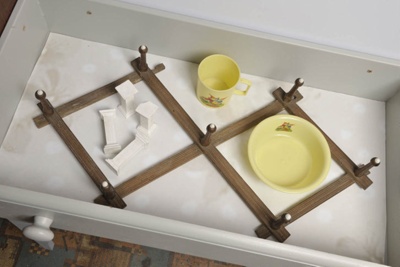Name/TitleCake decorations
About this objectWhite plaster, column shaped cake decorations to support a higher tier of, for example a wedding cake.
Research by Richard Hall, Volunteer:
Among the more ‘personal’ items in the Museum’s collection is a set of four, white plaster columns which were used for adding additional tiers to a cake or wedding cake.
The tradition of Wedding cakes can be traced back to Roman times, when a cake made of barley or wheat was broken over the bride’s head to bring good luck to the newly married couple.
In medieval times, the bride and groom had small cakes stacked, as high as possible, between them on their wedding day. A successful kiss over the pile of cakes meant that the couple would be guaranteed a prosperous life together. It is believed that this tradition gave rise to the traditional French ‘Croquembouche’, a tower mane of individual cakes of Choux Pastry filled with cream and stacked together, often with spun sugar wrapped around, which is still in use today.
During the 16th Century, it became the tradition to have a ‘Brides Pie’ at wedding feasts. The pie, itself was a savoury pie made with a pastry top to a recipe devised by Robert May in 1685. The savoury contents would be an assortment of meats and fish. May’s original recipe called for a compartment within the pie which contained live birds, which would be released for the entertainment of the wedding guests! It is unlikely that families of more modest means would have had such elaborate fillings.
The 17th Century saw the introduction of two pies. One for the Bride and another for the Groom. Rather than the savoury pies of earlier centuries, these were the first sweet cakes and very similar to today’s fruit cake, as used in modern wedding cakes. Their popularity was enhanced by the greater availability of sugar as a principal ingredient. Whilst sugar remained out of the reach of most households until the Victorian era, consumption actually doubled between 1690 and 1740.
The Grooms pie would have been a dark rich fruit cake but its popularity waned leaving only the Brides cake as the principle means of celebrating the wedding feast. A Brides cake, was nevertheless a very simple ‘pound cake’ with a white sugar icing. White denoting purity and virginity.
Victorian wedding cakes were traditional fruit cake, and often seen as a demonstration of wealth and power. With the marriage of Queen Victoria to Albert in 1840, Wedding cakes grew significantly in popularity among all classes of society. This led to more elaborate designs as cake icing techniques improved. The tiered cake, having up to three cakes on top of each other, of gradually reducing sizes. These were sometimes placed directly on top of each other and sometimes separated by columns, similar to those in the Museum collection, became popular at this time with folklore and superstitions evolving around the significance of each layer.
The bottom cake was to be shared with guests at the wedding breakfast. The middle tier would be used to share after the wedding, perhaps with friends unable to attend the event. The top tier was to be retained for the baptism or christening of the first child. Weddings like all social gatherings, were often an opportunity to catch up with old friends and family. To hear the lasts gossip and perhaps a tale or two.
These were among several objects donated to the Museum by Mrs Emily Wilding of Stowmarket and it is believed that decorations were used on her own wedding cake. Emily Wilding was a well-known figure in Stowmarket. She was a live in cook for the Longe family of Abbotts Hall in 1922. This is where she met her future husband Fred, who worked as a ‘farm horseman’. The pair married in November 1929 at Stowmarket Registry Office and Emily left her job at Abbott’s Hall to become a full time house wife for Fred. The couple lived in Seabreeze Cottage but Cottage into the Crowe Street Cottages where Emily took on the responsibility of running the estate dairy.
Medium and MaterialsWhite plaster
MeasurementsLength 7 and a half centimetres
Base 3 square centimetres
Object numberSTMEA:75.A.103.286(a-d)
Copyright Licence![]() Attribution - Non-commercial (cc)
Attribution - Non-commercial (cc)



